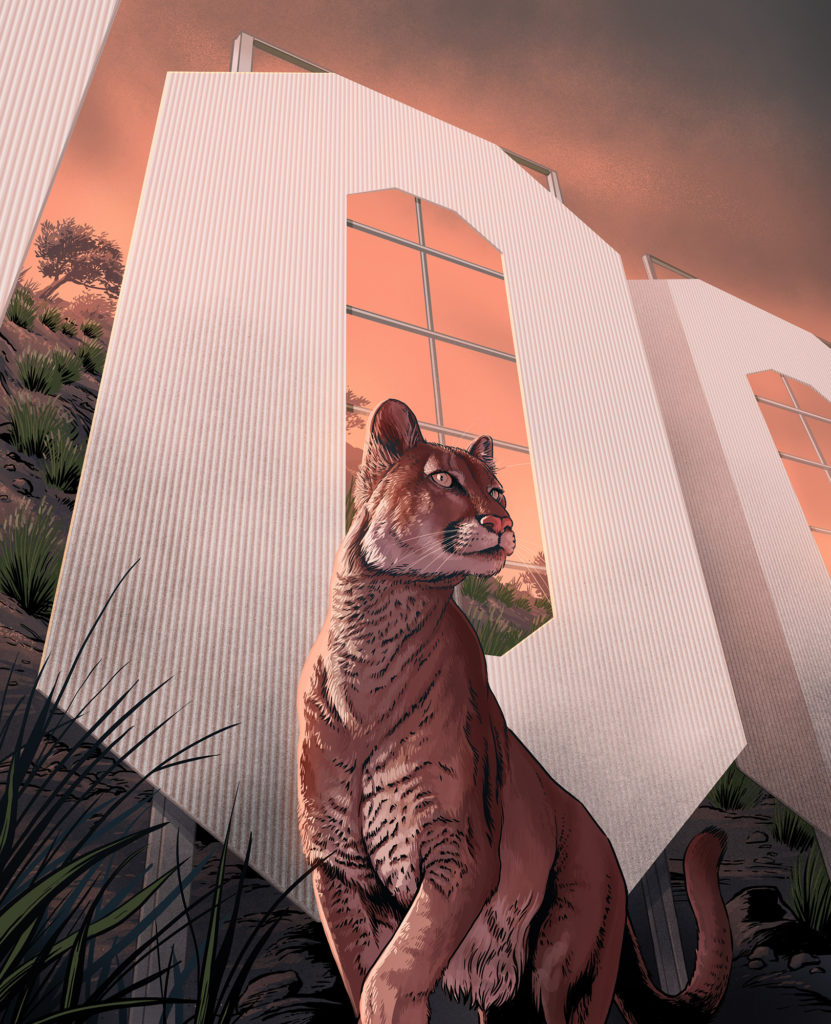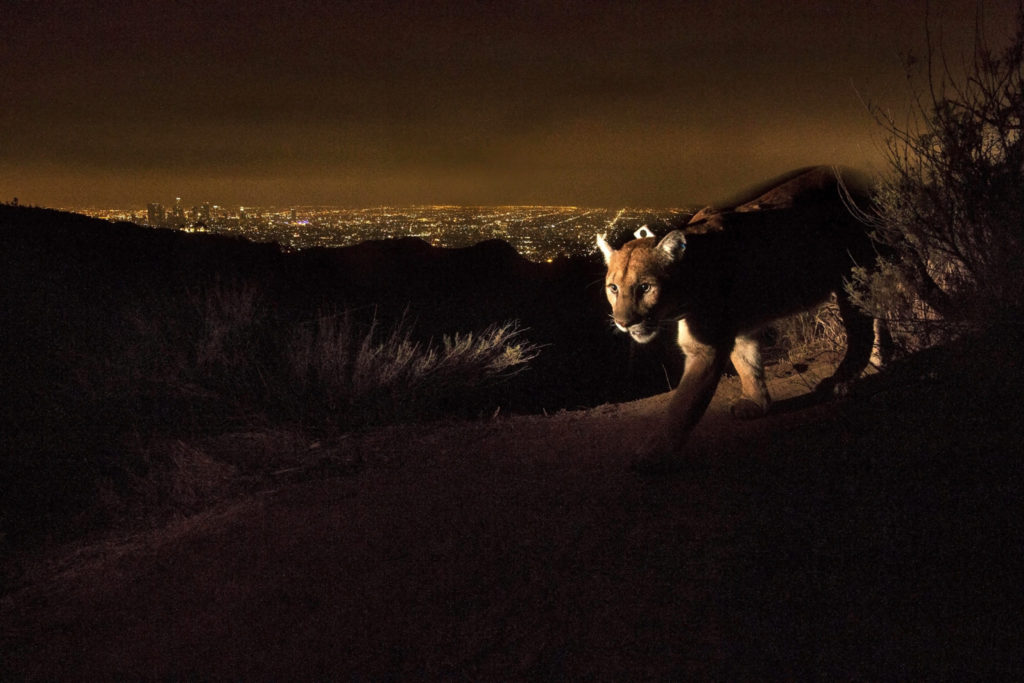
Liberty canyon winds through the blackened hills of Agoura, California, with verdant optimism. The Woolsey Fire leapt over this creek bed in 2018, and on a spring day, the sage, thistle, rosemary, willow, alder and oaks paint an impressionist tableau of vivid green splashed with mustard, violet and vermilion. It’s an Edenic V-necked valley, a sweet spot for nature to thrive — except for the sound of that perennial L.A. complaint, traffic.
The Ventura Freeway, California 101, splits Liberty in two. Four hundred thousand cars a day pass through here, their roar never completely dying. The state of California built the highway through the Santa Monica Mountains to connect the San Fernando Valley to the Pacific beaches. In doing so, it may have written the death warrant for one of this land’s oldest, most secretive, once hated but now celebrated creatures.
Long before the commuters, the hippies, the rock stars, the film crews, the ranchers, the missionaries — maybe even before the Chumash — mountain lions have called this rugged coastline their home. They were once the apex predator. Now, they may be our victim. More than 20 pumas have been killed on the 101 since 2002, the year researchers began studying the mountain lions of the Santa Monica Mountains.
Cars, rodenticide, fire and ranchers are picking off this panther population. But the biggest threat is a genetic time bomb: Ringed in by the ocean, the city and the highways, the cats have been forced to interbreed. Mutations discovered by scientists this past summer indicate that the clock is ticking for these animals. Cougars need hundreds of square miles to call their own. The lions of the Santa Monica Mountains are running out of space and time.
But not if we can help them.
While a few cougars seem to have successfully crossed the 101 in search of mates, others have died trying.
An extraordinary movement has grown around this strip of land. A coalition of government agencies, nonprofits, Hollywood luminaries, local residents, and cat ladies and gentlemen worldwide are raising $87 million to build the lions, and all their animal friends, a bridge over the 101. One couple in Kansas donated half a million dollars to the Liberty Canyon wildlife crossing. Leonardo DiCaprio has his whole foundation involved. In May, the Annenberg Foundation announced a $25 million challenge grant for the pumas. With $44 million raised so far, they hope to break ground by yearend.
Los Angeles has gone cougar crazy.
Puma concolor is the second largest cat of the Americas and the only “big cat” found in the United States outside of the southwest border areas, where you can sometimes find jaguars. (“Big cat” is not an official scientific term, and if it were, mountain lions break the mold: They can’t, don’t and won’t roar, preferring silence, or the occasional purr, squeak or scream.) Like an actor playing characters, the mountain lion is known by more names (40) than any other species, including panther, catamount, painter, puma and cougar. However, this feline shuns the limelight — hence one of my favorites of its many anti-stage names: ghost cat.
The handsome face, lithe body, giant paws and long bushy tail of the puma have captivated me since I was a kid. A house cat in a big cat’s body, cougars are the American heartthrob: silent, athletic, powerful, but soft and cuddly, too. They are not flashy like tigers or bossy like African lions. Free of manes, tufts, stripes or spots (except as kittens — and OMG, they are the most adorable kittens), there is something plain-spoken, proletarian, downright democratic about panthers. They’re like characters in a Sam Shepard play, or the late playwright/actor himself: rugged, resourceful, renegade. Found from Canada to Patagonia, they are literally all-American. Obligate carnivores, if they don’t eat red meat, they die. Cougars are 150-pound ambush predators, who purr.
For me, they are not just a totem American animal; they are also a symbol of California, one of the Western states where cougars still thrive, and that is my native territory, too. Born in Glendale, I moved to Wisconsin when I was 4. Growing up, I remained deeply connected to the land of my birth. By imagining, in the games I played with my childhood friends in small-town Midwestern yards, that I was a mountain lion, I could also relocate myself out West, to the mountains, deserts and sea, where I belonged.
Sometimes dreams come true, and 10 years ago, I finally came home. And then, to my amazement, so did the man of my dreams: a lean, muscular, quiet but deadly single feline male, the most famous eligible bachelor of the Hollywood Hills, P-22.
Like a legend who has turned reclusive, P-22 was first caught in the flash of a bulb in 2012. He tripped a camera placed by rangers in the wilds of Griffith Park, and lo, there he was, Puma concolor, adult male. The Griffith Park cat was the 22nd animal identified in the scientific study of the area. The P stands for puma.
Cougars need hundreds of square miles to call their own. The lions of the Santa Monica Mountains are running out of space and time.

Griffith Park is a 4,210-acre green polygon in the middle of Los Angeles visited by 10 million people a year. It’s home to the L.A. Zoo, the Griffith Observatory, the Autry Museum of the American West and, it turns out, enough wilderness to hide a lion. The discovery of a wild carnivore living in the middle of America’s second biggest city was big news, to the public and to the experts.
“There’s no way that’s true,” Beth Pratt recalls thinking when she first read about P-22 in the L.A. Times.
As the person in charge of building the National Wildlife Federation’s California office, Pratt needed to find out more. She called Jeff Sikich, the National Park Service biologist who, along with biologist Seth Riley, is in charge of the Santa Monica Mountains panther study. He took her on a backwoods tour of P-22’s terrain, which may sound glamorous but, as Pratt says, “meant crawling through poison oak to look at rotting deer carcasses.” At first, she thought, “Oh, mother of god, get this cat out of here. But as Jeff talked about it, I had this life-changing moment: If this is the only way this cat can have a life, it’s not my call; it’s his.”
Once she was convinced P-22 was no mythical Sasquatch, Pratt had one question for Sikich: “What can I do to help?
“Well,” the ranger responded, “there’s this little wildlife crossing we need built.”
No one knows for sure how or when P-22 got to Griffith Park. He had to cross the 405 freeway and the 101, and pass through city streets and backyards like a, um, cat burglar. Having arrived, he seems to be in no hurry to leave his publicly funded bachelor pad. He survives on a steady diet of the park’s deer population and, apparently, the occasional koala; in 2016, one was found mauled at the zoo. While the typical male panther will wander 100 miles to find a mate, P-22 seems to have chosen solitudinous survival over the procreation urge.
Who needs sex when you’re a social media star? Angelenos keep swiping right on P-22’s profile. There are multiple Twitter and Facebook accounts for the elusive beast — playing hard to get is the ultimate love game, after all. There is a P-22 stuffed animal (funds go to the wildlife crossing) and a virtual P-22 Day, on Oct. 23 this year. P-22 in particular, but also his entire feline family, has captured the imagination of Angelenos. Dubbed by Pratt “the Brad Pitt of the cougar world,” he is the ambassador and symbol of wildlife’s changing relationship to urban spaces.
“It’s been really exciting to see how many people have rallied around these animals, especially P-22,” says Sikich. “It’s this large carnivore living among millions of people; that alone sparks people’s interest. It’s a great survival story. Their elusive nature and their adaptability have kept them here: You find them in high elevations, the desert and large developments. I like knowing they’re out there; it gives you a sense of excitement. It is a testament to what we’ve been able to do with conservation in the area.”
Like any romantic protagonist, P-22 symbolizes hope, but also an existential quandary: If a female panther doesn’t somehow wander into Griffith Park, his genes will die out with him. All the Santa Monica Mountains lions face this extinction crisis. While a few cougars seem to have successfully crossed the 101 in search of mates, others have died trying. Those who remain trapped in the hills have turned to in-breeding, which causes genetic damage. In the case of P-81, trapped and tagged last summer, this is a kinked tail and undescended testicle. These animals face the same genetic catastrophe that almost wiped out their similarly stranded cousins, the Florida panthers. In short, if they can’t get across that highway and mix up the gene pool, these magnificent creatures are doomed.
“P-22 is the relatable victim on the scene. He gets people’s hearts to understand what the cougars are facing,” says Pratt, who now heads Save LA Cougars, the branch of the National Wildlife Federation that raises money for the 101 wildlife crossing. “He’s a game changer in people’s perception of where wildlife should be and our relationship to nature. We have to get over the notion that city people don’t live with wildlife; they do.”
Fortunately for the cougars, one of the things Angelenos like almost as much as a sexy bachelor sob story is the prospect of building something new and momentous. Wildlife crossings have been constructed everywhere from Europe to Washington to Temecula, but the proposed 101 bridge, 165 feet wide by 200 feet long and covered in terrain, will be the most ambitious, and expensive, of its kind. Twenty percent of funds will come from public conservation efforts; the rest are private donations. Hopefully by 2023 some young male puma looking to establish his own territory will cross over from the Los Padres National Forest to the north and, you know, get lucky.
Evelyn McDonnell, a frequent contributor to LMU Magazine, is a professor of journalism in the LMU Bellarmine College of Liberal Arts. She has written or coedited seven books, including “Queens of Noise: The Real Story of the Runaways” and “Women Who Rock: Bessie to Beyonce. Girl Groups to Riot Grrrl.” Follow her @EvelynMcDonnell.
